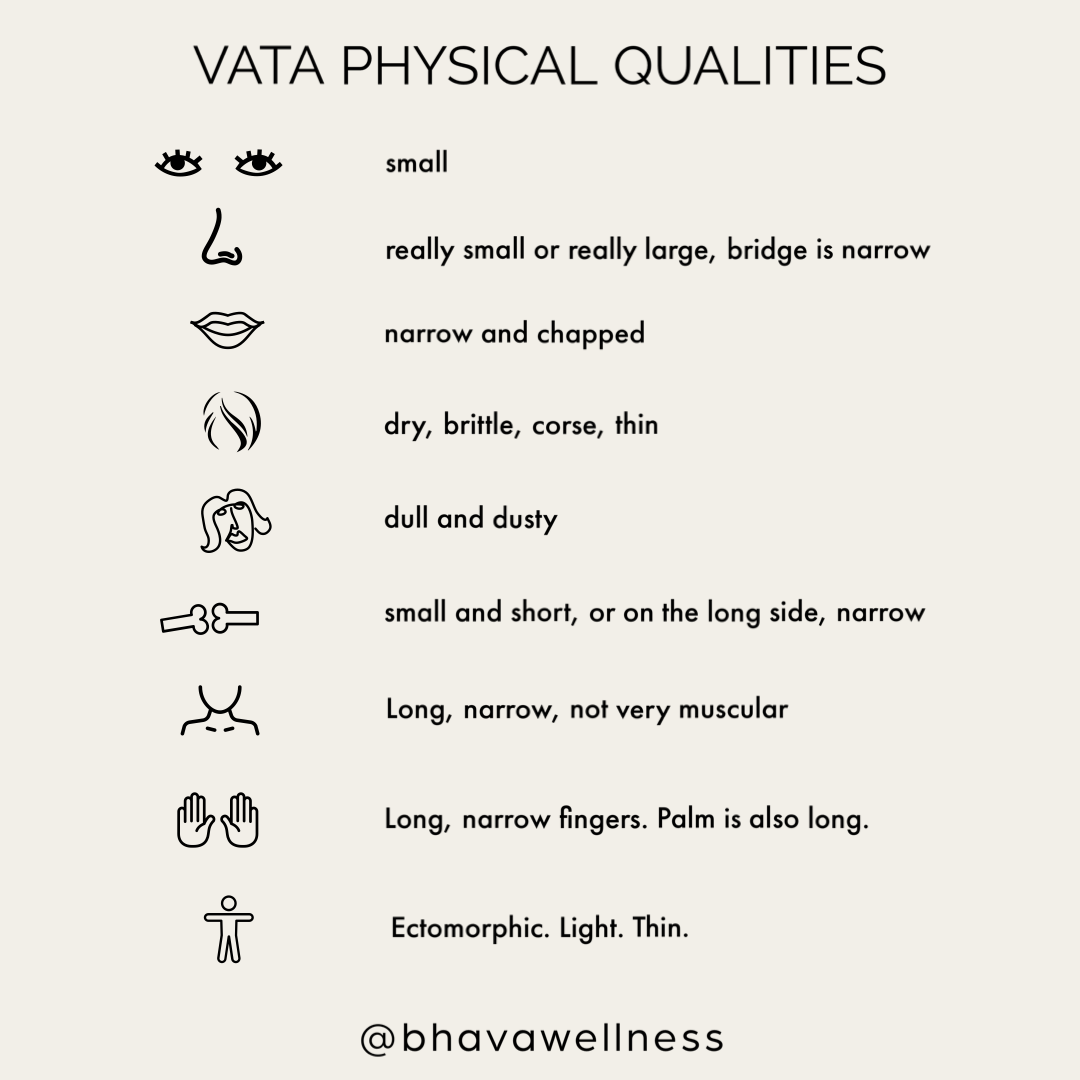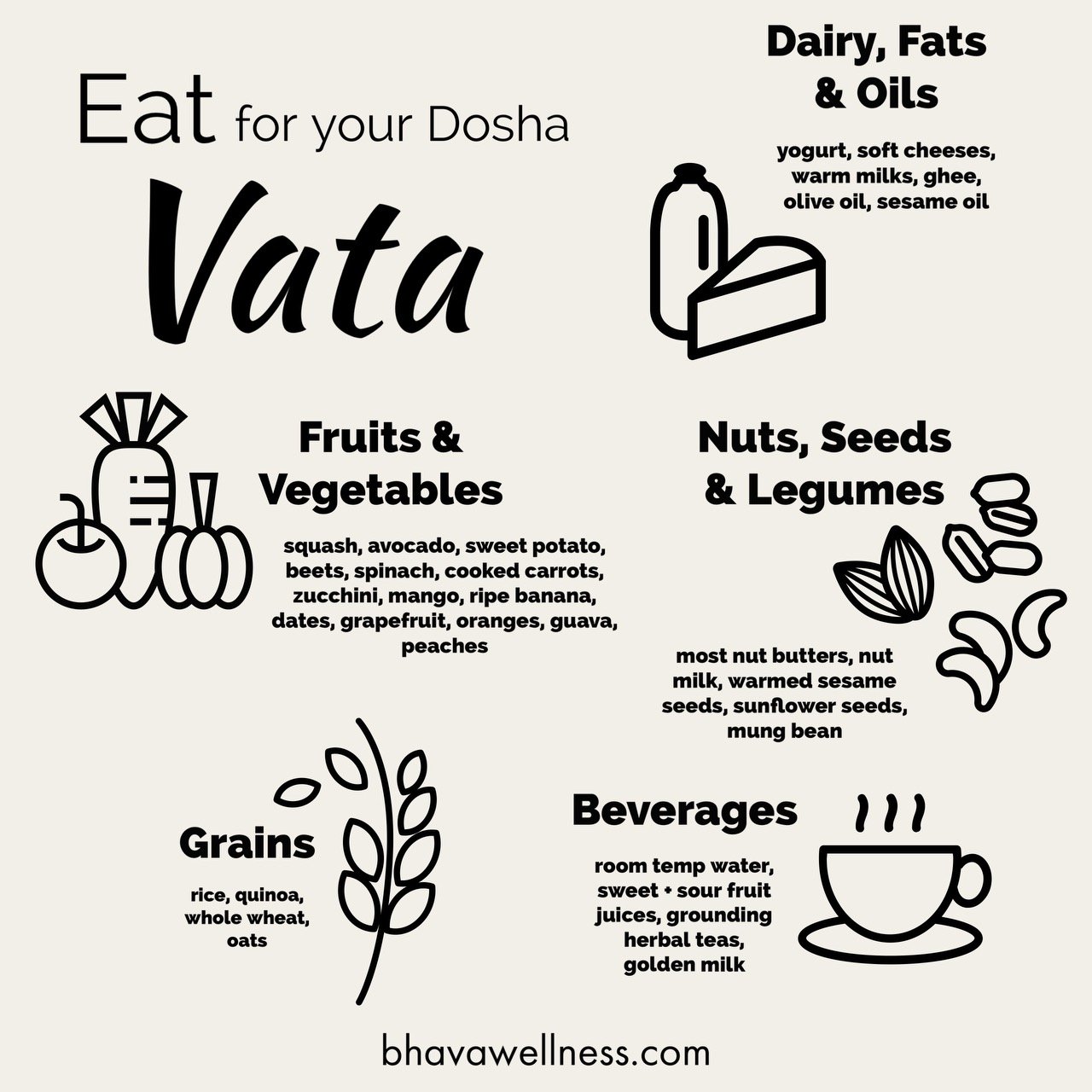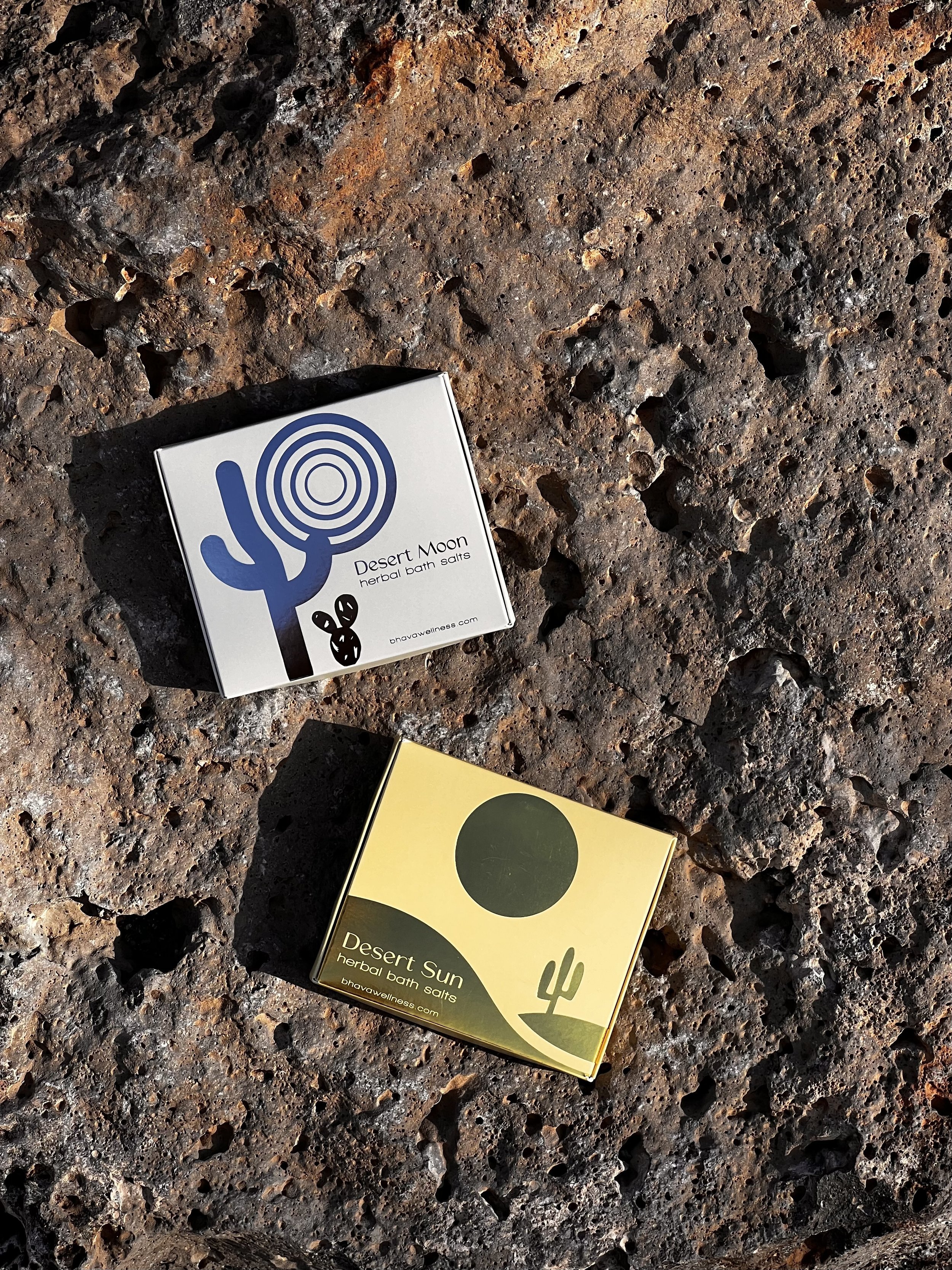Vata dosha
is the force within the body responsible for all motion. This dosha is made up of the air and ether elements. A person of Vata nature’s qualities reflect it’s elements. Vata is cold, dry, subtle, rough, and mobile. Vata creates these qualities in the body & mind.
We all should have a balanced amount of Vata) but when Vata increases over it’s natural amount in the body, it’s primary symptom & complaint is pain. Since Vata governs movement, other symptoms include excess motion: twitching, restless leg, rapid breathing, anxiety, rapid heart rate, dizziness, wandering thoughts, & too much air in the digestive tract.
Appetite:
The appetite of a person with a vata imbalance is variable. It could move from extreme hunger at times, to being way to full, to forgetting to eat. Meals tend to be irregular, this is no good because it directly effects the mood short term & your over all health long term.
Digestion:
Digestion can also be variable for a person of Vata dosha. There can be dryness in the colon that causes gas and constipation. At times because of the variable nature of Vata, a person can fluctuate between constipation and diarrhea.
Sweat:
People of this constitution tend to sweat less than others, they tend to run a little cool and at times very dry.
Temperature:
People of vata nature tend to run cool and even cold at times. With their light quality, it is more difficult to retain heat. Circulation problems can arise within people of this constitution.
Skin:
skin tends to run on the dry side for people of Vata nature. This can result in cracking, flaking, dry rashes and the skin can look dull at times.
Menstruation:
Menstruation tends to be on the lighter side, scanty and dryer. Cycles tend to run shorter (2-5 days) and sometimes not at all.
Sleep:
Often there is difficulty sleeping for someone with a Vata imbalance. Sleep is light & restless and it can be hard to get back to sleep if they wake up. When stress or anxiety is present, sleep becomes even more difficult.
VATA balancing DIET
below is a quick chart to set the mood…please see below for more information around a pacifying Vata Diet
Vata balancing herbal offerings
Embrace Slow, Doable Shifts
A vata-pacifying diet is a practice more than it is a series of absolutes.
We can’t expect ourselves to wake up tomorrow morning & eat a perfect vata balancing diet everyday but learning about what to eat to help create more balance in our lives is really empowering.
In Ayurveda, we practice the 3o/70 rule where we really try to do our best 70% of the time and then 30% of the time we are allowing ourselves a little room to make mistakes, have a little extra fun, eat that extra SLice of Pizza so that we can further learn and grow.
Following a vata-pacifying diet is not a matter of being rigid and living to a strict set of dos and don’ts, or letting our minds get to obsessed and overtaken in the details. It is so much more doable to pay our attention to the proactive overarching patterns. At the end of the day, any and all self work to help bring you more balance should be considered a win.

We are human and we typically enjoy food that is vata-aggravating, so next time this happens…notice how you feel when you do eat it.
Does it increase the of vata symptoms in your digestive tract like gas, bloating, or constipation?
Are there small steps you can take to serve this food in a more vata-pacifying manner—perhaps by adding extra oil, ghee, and digestive spices. Are you serving this meal warm?
Isn’t it exciting to think that you can put to use your growing awareness to inspire small steps forward?
Meanwhile taking the time to journal and keep tabs on how your health and overall well-being are improving over time. As you put in the work to bring balancing through your Ayurvedic diet and lifestyle changes, it is likely that your overall health will improve.
Qualities to Favor
Now that you are ready to take this on, we want to take a mixture to introduce the qualities that you’ll want to favor in your diet and the qualities that generally tend to be vata-aggravating.
By nature, vata is cool, dry, rough, and light, so eating foods that neutralize these qualities—foods that are warm, moist, oily, smooth, and nourishing—will help to balance excess vata. Our intention is to provide you a more intuitive understanding of what will soothe vata, without having to constantly reference lists of foods to favor and avoid.
Favor Warm Over Cold
The warm quality of what we are taking in should be practiced by eating foods, herbs, and spices that are warm in temperature and energetics. For Vata dosha, it is best to minimize foods with a cooling energy, such as cold and frozen foods or drinks, carbonated drinks, large quantities of raw fruits and vegetables, and even leftovers that have been kept in the refrigerator or freezer. The cold quality is inherently increased in these foods, so freshly cooked is best.
Favor Moist & Oily Over Dry
We try to offset Vata’s dryness by eating cooked rather than raw foods and by cooking and preparing foods with generous amounts of high-quality oils. Always be sure to be hydrating with plenty of fluids, ideally warm or hot and no cooler than room temperature.
Moist foods like berries, melons, summer squash, zucchini, and yogurt help to offset vata’s dry quality, as do hydrating preparations such as soups and stews. Oily foods like avocado, coconut, olives, buttermilk, cheese, eggs, whole milk (preferably non-homogenized), wheat, nuts, and seeds are generally supportive as well.
Favor Grounding, Nourishing, + Stabilizing Over Light
We like to think in terms of grounding vata’s lightness with food of sustenance, so eating foods that offer grounding and more stabilizing sources of energy tend to provide deep nourishment to the physical body and emotional mind.
Generally foods that help to balance Vata dosha will naturally taste sweet. Ideal examples include cooked grains, spiced milk, root vegetables, stewed fruits, nuts, and seeds. Highly processed foods such as canned foods, ready-made meals, and pastries are often quite heavy and they lack prana (vital life-force energy). and are generally quite aggravating to vata. People of Vata nature should also avoid stimulants such as caffeine, nicotine, and hard alcohol should be minimized or avoided because they aggrivate vata’s need for grounded stability.
Favor Smooth Over Rough
In general Vata tends to resist large quantities of raw vegetables, and should enjoy raw fruits in moderation. Even cooked, foods like broccoli, cabbage, cauliflower, dark leafy greens, and many beans are exceptionally rough and may be best minimized while you are working on pacifying vata.
If you do eat them, cook these foods well and serve them with generous amounts of oil or ghee and add some vata pacifying spices. Preparing and eating foods that are smooth in texture— like bananas, rice pudding, warm oatsl, hot spiced milk, root veggies, and puréed soups for example can really help to soothe vata’s roughness.

How to Eat
When it comes to pacifying vata, how we eat may be just as important as what we eat, so this is an especially useful place to focus if the prospect of radically changing your diet feels overwhelming right now.
Vata is deeply soothed when we choose to eat in a peaceful environment—one where we can offer our full attention to the act of being nourished. Routine itself also balances vata, so the practice of eating three square meals per day (at about the same times each day) further reduces vata and helps to strengthen delicate digestion. And as we have already discussed, the aggravating potential of many vata-aggravating foods can be minimized by making sure that they are well-cooked, served warm, and garnished generously with oil, GhEE and digestive spices.
Even visualizing your food grounding your energy, nourishing your body, and promoting health and vitality can go a long way toward pacifying the negative impacts of a vata-aggravating food. Experiment with taking a moment to resonate with your food in this way, particularly if you know you are about to ingest a food or a meal that is especially cool, dry, light, or rough.
Lastly, because vata requires regular nourishment, it is best to avoid fasting. If you feel the need to do a cleanse of some sort, a monodiet of KItchari is much less vata-provoking than a fruit or juice cleanse, and is certainly better than an all-out fast.
Suggested Meals
Breakfast
Breakfast is a critical meal when vata is elevated. After an overnight fast, vata needs real nourishment. A hearty breakfast is generally very stabilizing to the entire system when vata is elevated, provided it is not too heavy for one’s digestive capacity.
Lunch
Ideally, lunch is the main meal of the day, meaning it’s the largest and the most nourishing of the three. Hearty grains, steamed and sautéed vegetables, breads, soups, and stews are excellent building blocks for lunch. This is also the best time to enjoy a small salad if you must have one.
Dinner
Dinner is ideally a bit smaller and lighter than lunch. But to soothe vata, it needs to offer adequate nourishment. Soups, stews, or a smaller serving of lunch often fit the bill.

Fruits
Fruits that pacify vata are generally be sweet and nourishing. While some raw fruit is appropriate, cooked or stewed fruits are easier to digest and offer additional warmth, moisture, and sweetness—which makes them even more beneficial for vata. Fruits to avoid are those that are exceptionally cooling, astringent (drying), or rough, which includes most dried fruit (unless it has been soaked or cooked to rehydrate).
And remember, fruits and fruit juices are best enjoyed alone—30 minutes before, and ideally at least 1 hour after, any other food. This helps to ensure optimal digestion.
Favor
Apples (cooked)
Applesauce
Apricots
Bananas (ripe, not green)
Berries
Cantaloupe
Cherries
Coconut
Dates (fresh, cooked, or soaked)
Figs (fresh, cooked, or soaked)
Grapefruit
Grapes
Kiwi
Lemon
Lime
Mango
Melons
Oranges
Papaya
Peaches
Pineapple
Plums
Prunes (cooked or soaked)
Raisins (cooked or soaked)
Tamarind
Avoid
Apples (raw)
Bananas (green)
Cranberries
Dates (dry)
Dried Fruit, in general
Figs (dry)
Pears
Persimmons
Pomegranate
Prunes (dry)
Raisins (dry)
Watermelon
Vegetables
Vegetables that pacify vata are generally be sweet, moist, and cooked. Root vegetables are especially beneficial because they grow underground, and are therefore supremely grounding and stabilizing for vata. Avoid exceptionally dry, rough, and cold vegetables, including most raw vegetables. If you must have raw veggies, a salad, or any of the vata-aggravating vegetables, keep the quantities small and eat them at mid-day, when digestive strength is at its peak. A really thorough cooking or a well-spiced, oily dressing will help to offset some of the dry, rough qualities of these foods.
Favor
Asparagus
Avocado
Beets
Carrots, Cooked
Chilies (in very small quantities)
Cilantro
Cucumber
Garlic
Green Beans
Green Chilies
Leeks
Mustard Greens
Okra
Olives (black)
Onion, Cooked
Parsnip
Peas, Cooked
Pumpkin
Rutabega
Spinach, Cooked
Squash, Summer
Squash, Winter
Sweet Potatoes
Watercress
Zucchini
Reduce or Avoid
Artichokes
Beet Greens
Bell Peppers
Bitter Melon
Broccoli
Brussels Sprouts
Burdock Root
Cabbage
Carrots, Raw
Cauliflower
Celery
Chilies (in excess)
Corn, Fresh
Dandelion Greens
Eggplant
Jerusalem Artichokes
Kale
Kohlrabi
Lettuce
Mushrooms
Olives, Green
Onion, Raw
Peas, Raw
Peppers, Hot
Potatoes, White
Radishes
Spinach, Raw
Sprouts
Tomatoes
Turnips
Grains
Grains that pacify vata are generally sweet, nourishing, easily digested, and well cooked. Mushy grains and puddings (things like oatmeal, cream of wheat and rice pudding) exemplify the smooth quality and, when sweetened and spiced, are often delicious comfort foods. Avoid grains that are exceptionally light, dry, or rough, or especially dense and heavy. It is one or more of these qualities that gives the grains in the “avoid” column below, their capacity to disturb vata.
Favor
Amaranth
Durham Flour
Oats, Cooked
Pancakes
Quinoa
Rice (all types)
Seitan
Sprouted Wheat Bread
Wheat
Avoid
Barley
Buckwheat
Cereals (cold, dry, or puffed)
Corn
Couscous
Crackers
Granola
Millet
Muesli
Oat Bran
Oats, Dry
Pasta, Wheat
Rice Cakes
Rye
Spelt
Tapioca
Wheat Bran
Yeasted Bread
Legumes
Vata can enjoy a narrow selection of legumes, provided they are well-cooked and well-spiced. The beans that work best for vata are a little less dense, rough, and dry, than other legumes. They tend to cook relatively quickly, are easily digested, and offer a grounding, nourishing quality. Many other beans are simply too dry, rough, and hard for vata’s delicate digestion.
Favor
Lentils, Red
Miso
Mung beans
Mung dal spit
Soy Cheese
Soy Milk (served warm)
Soy Sauce
Soy Meats
Tofu (served hot)
Toor Dal
Urad Dal
Avoid
Adzuki Beans
Black Beans
Black-Eyed Peas
Garbanzo Beans (Chickpeas)
Kidney Beans
Lentils, Brown
Lima Beans
Navy Beans
Pinto Beans
Soy Beans
Soy Flour
Soy Powder
Split Peas
Tempeh
White Beans
Dairy
Dairy products are generally quite balancing for vata, but it’s good to avoid highly processed preparations (like powdered milk), and especially cold dairy products. For example, boiled cow’s milk (ideally a non-homogenized variety) spiced with cinnamon and nutmeg, sweetened if desired, and served hot, is a tonic for vata, whereas cold cow’s milk may be too difficult for many to digest. As a rule, dairy milks (cow’s milk, goat’s milk, sheep’s milk, etc.) should be taken at least one hour before or after any other food. For this reason, avoid drinking milk with meals. Almond and rice milks are good substitutes, if you need to combine milk with other foods, or if you don’t digest dairy milks well.
Favor
Butter
Buttermilk
Cheese
Cottage Cheese
Cow’s milk
Ghee
Goat’s Milk
Ice Cream (in moderation)
Sour Cream (in moderation)
Yogurt (fresh)
Avoid
Frozen Yogurt
Powdered Milk
Nuts & Seeds
In moderation, all nuts and most seeds are pacifying to vata. They are oily, nutritious, and they offer a power-packed combination of proteins and fats that’s highly beneficial to vata. That said, nuts and seeds are quite heavy and should be eaten in small quantities so as not to overwhelm vata’s fickle digestive capacity.
Favor
Almonds
Brazil Nuts
Cashews
Coconut
Hazelnuts
Macadamia Nuts
Peanuts
Pecans
Pine Nuts
Pistachios
Pumpkin Seeds
Sesame Seeds
Sunflower Seeds
Walnuts
Avoid
Popcorn
Oils
Because toxins tend to concentrate in fats, buying organic oils may be more important than buying organic fruits and vegetables. Most oils are beneficial for vata, provided they are high-quality oils. Sesame oil, almond oil, coconut oil, olive oil, and ghee are among the best choices. Less favorable oils are either too light and dry, too difficult to digest, or too highly processed/altered for vata.
Favor
Almond Oil
Avocado Oil
Castor Oil
Coconut Oil
Ghee
Mustard Oil
Olive Oil
Peanut Oil
Safflower Oil
Sesame Oil
Sunflower Oil
Avoid
Canola Oil
Corn Oil
Flax Seed Oil
Soy Oil
Spices
Most spices are wonderful for vata, provided that none of your dishes are fiery hot (due to excessive use of cayenne pepper, chili peppers, and the like). Experimenting with a wide variety of new and exotic spices is generally great for vata, and can help to kindle overall digestive strength.
Favor
Ajwan
Allspice
Anise
Basil
Bay Leaf
Black Pepper
Caraway
Cardamom
Cinnamon
Cloves
Coriander
Cumin
Dill
Fennel
Garlic
Ginger (fresh or dried)
Hing (Asafoetida)
Mace
Marjoram
Mint
Mustard Seeds
Nutmeg
Oregano
Paprika
Parsley
Peppermint
Pippali
Poppy Seeds
Rosemary
Saffron
Salt
Savory
Tarragon
Thyme
Turmeric
Vanilla
Use in Moderation
Cayenne Pepper
Chili Powder
Fenugreek
Horseradish
Neem Leaves









